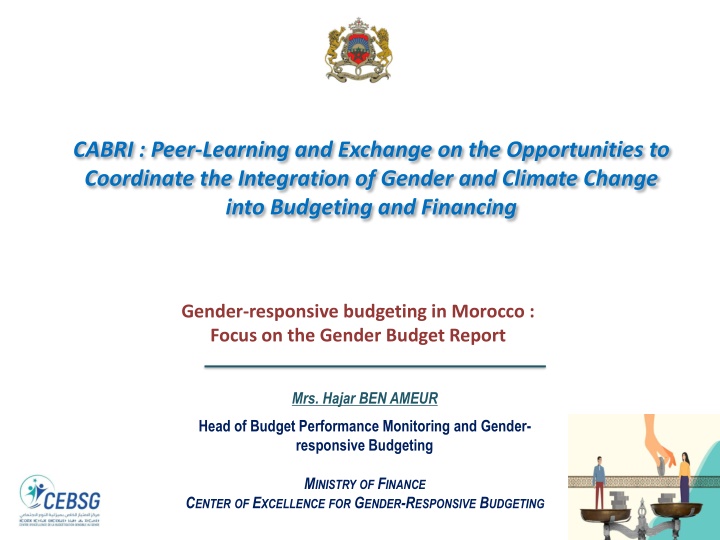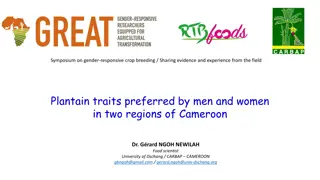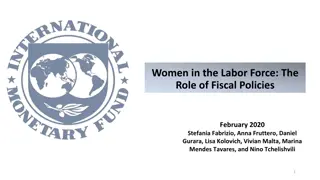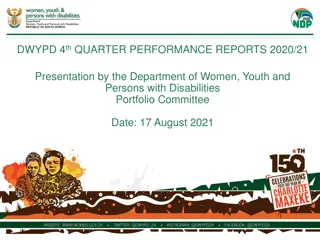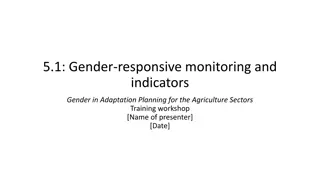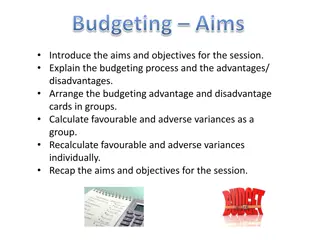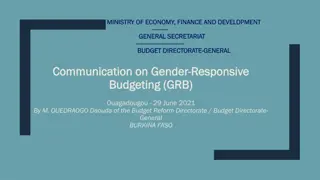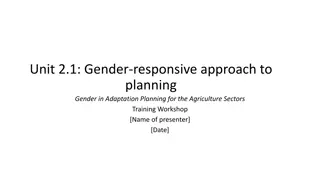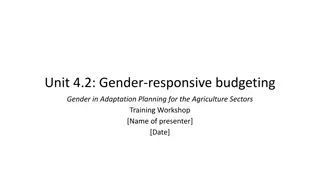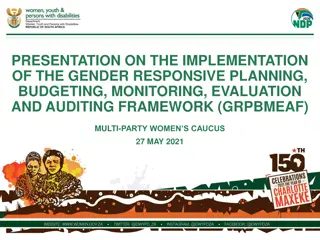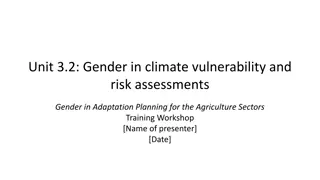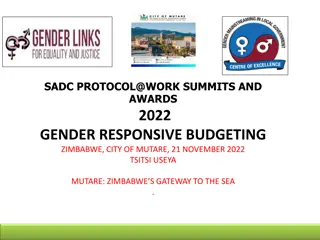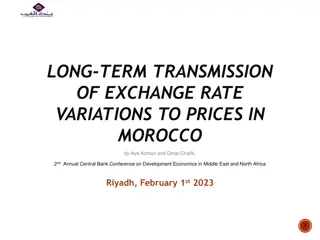Gender-Responsive Budgeting in Morocco: 20 Years of Experience and Future Directions
This document explores the journey of Gender-Responsive Budgeting (GRB) in Morocco over the past two decades, highlighting the significant milestones, legal frameworks, and initiatives that have shaped the integration of gender and climate change considerations into budgeting and financing. The narrative delves into the structural shifts in policy-making, the emphasis on equality frameworks, and the transformative impact on public policies through a gender lens.
Download Presentation

Please find below an Image/Link to download the presentation.
The content on the website is provided AS IS for your information and personal use only. It may not be sold, licensed, or shared on other websites without obtaining consent from the author.If you encounter any issues during the download, it is possible that the publisher has removed the file from their server.
You are allowed to download the files provided on this website for personal or commercial use, subject to the condition that they are used lawfully. All files are the property of their respective owners.
The content on the website is provided AS IS for your information and personal use only. It may not be sold, licensed, or shared on other websites without obtaining consent from the author.
E N D
Presentation Transcript
CABRI : Peer-Learning and Exchange on the Opportunities to Coordinate the Integration of Gender and Climate Change into Budgeting and Financing Gender-responsive budgeting in Morocco : Focus on the Gender Budget Report Mrs. Hajar BEN AMEUR Head of Budget Performance Monitoring and Gender- responsive Budgeting MINISTRY OF FINANCE CENTER OF EXCELLENCE FOR GENDER-RESPONSIVE BUDGETING
THE REFERENCE FRAMEWORK FOR EQUALITY IN MOROCCO The 2011 Constitution Conventions, protocols and agendas : BEIJING, CEDAW, SDGs Royal Incentives Government programme 2017-2021 Plans of the Government on Equality ICRAM 1 2012-2016 and ICRAM2 2017-2021 Morocco-Attamkine Programme for economic autonomy of women and girls by 2030 National Policy to combat violence against women and girls by 2030 The New development model 2
GRB IN MOROCCO: 20 YEARSOFEXPERIENCE Close support of Ministerial departments Methodological and conceptual enhancement for the deployment of GRB 2020-2021 Establishment Anchoring 2016-2019 Foreshadowing performance-driven GRB Foreshadowing 2015 3 Organic Law No. 130-13 of the Finance Law making GRB compulsory for all Ministries Organic Laws No. 111-12, No. 111-13, No. 111-14 making gender-sensitive planning mandatory at local level Realisation Legislations 2013 Creation of the Center of Excellence for GRB Agency 2 2009-2012 Capacity building and training of Ministerial departments on understanding and the challenges of GRB Training Preparation of the first issue of the Gender Report accompanying the 2006 PLF Enhancement of the National Information system with gender-sensitive data Launching 2005 Tools 2001-2004 Awareness and capacity building Partnership with UN Women Study on"The methodological feasibility of gender and child budget accounts": : recommendations for the GRB in Morocco Awareness 1 3
GRB IN MOROCCO: A SUPPORT AT THE LEVEL OF THE ORGANIC LAW RELATING TO THE FINANCE LAW Articles of OFL130-13 Implication for the budget programming of ministerial departments Content ".... The gender aspect is taken into when setting objectives and indicators ...." The budget programme of each department must be associated with objectives to reduce inequalities, including the achievement of results measured by indicators consideration Article 39 Report accompanying the presentation of the draft Finance Law Tool to analyse public policies in relation to the principles of gender equality ".... Budget reporting based on the results taking into account the gender aspect .... " Article 48 4
THE RESULTS-BASED BUDGET REPORT WHICH FACTORS IN THE GENDERASPECT (GRB) IN MOROCCO GRB: Instrument for analysis and evaluation under the gender prism of public policies developed in line with a process Progressive, reflected in the expansion of the number of ministerial departments it covers ; Participatory, in the involvement of ministerial departments in its drafting ; Iterative, produced annually when the Finance Bill is presented in Parliament. 5
GRB: MORE THAN 15 YEARS OF PRACTICE Objectives of GRB: Present the efforts made by the ministerial departments within the framework of their programmes and budgets with regard to the promotion of equality and strengthen the accountability of the Government vis- -vis the parliament and the citizens 2018-2019 : 27 Departments 2020: Redesign of the Report Analytical approach that tries to apply a gender-sensitive performance approach 2010: 21 Departments Integration synthesis into the RG and a gender analysisof performanceindicators of a cross-sectional 2005: 4 Departments Rigid analytical framework: a gender analysis of the situation, an analysis of public priorities, programmes and projects implemented as well as a gender analysis of budgets 6
MAIN IMPROVEMENTS TO THE GRB Improving the relevance of gender-sensitive results chains Gender-sensitive data collection and analysis Alignment between GRB development processes and performance documents Alignment between the GRB and the Government Plan for Equality (PGE II) Annual analysis of topics related to GRB that benefit the economic prosperity of the country Strengthening of the coordination between ministerial departments 7
GRB TODAY: ORGANISED AND COORDINATED STAKEHOLDER ENGAGEMENT Involvement of Top Management Continuous enrichment of information systems with gender-sensitive data (coordination with the HCP) Regular use of GRB capacity building Gradual operationalisation of intersectorality Improving gender-responsive result- chains 8
GRB: A MORE STRUCTURED CONTENT BASED ON THE CONTRIBUTION OF THE MINISTRIES Introduction Purpose of the GRB Explanation on the new GRB elements and their content I. Macro-economic importance of gender equality Findings from studies on the macro-criticality of gender equality as an integral part of promoting stability and economic growth II. For effective gender equality: Major advances and strengthening tools Legislative and institutional progress in institutionalising gender equality in public policies and promoting the culture of equality, briefly highlighting particularly significant new achievements in specific sectors in support of gender equality between women and men III. Towards an application and appropriation of a gender-sensitive performance approach by ministerial departments 1. 2. 3. Legal and institutional foundations for gender equality Continued efforts for equitable access to social services and basic infrastructure Equitable access to factors of production for greater economic empowerment of women Statistical appendices Situation of gender inequalities in the organisational structures of the Department Access of women and men to public service in the sectors of activity for which the relevant Department is responsible 9
GRB: MAINPERSISTINGCHALLENGES Integration of gender-sensitive aspects at the end of the results-chain (indicators or sub-indicators). Which implies : - Few gender-targeted programmes - Limited number of gender targets - Significant number of gender- sensitive indicators Concepts related to gender equality in general and GRB in particular, are not yet fully understood in a harmonised way by ministerial departments An adoption of a "top-down and bottom-up" process for the genderisation of the results-chains to be allocated Use of sectoral gender assessments to be systematised A common understanding of GRB to be strengthened Gender analysis is an essential prerequisite for any action aimed at promoting gender equality; The availability and analysis of gender- sensitive data are challenging for some sectors ... 10
